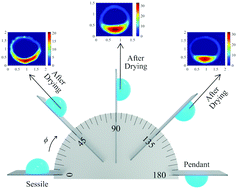Patterns from drops drying on inclined substrates†
Abstract
The coffee ring effect results from the migration of particles in a drying particle laden drop and their subsequent deposition at the three phase contact line. The evaporative flux during the drying of sessile drops and the spatial distribution of particles in the coffee ring patterns exhibit azimuthal symmetry. It is possible to break this symmetry with the help of gravity by simply manipulating the inclination of the substrate on which the colloidal droplet undergoes drying. However, the effect of particle size, substrate wettability and inclination angle on the extent of asymmetry in the spatial distribution of particles over the deposit patterns has not been explored and is the subject of the current work. Our experiments on the drying of aqueous dispersions of polystyrene particles show that (i) asymmetry in the deposition of particles is observed irrespective of the diameter of the dispersed particles in the drying drop (ii) the degree of asymmetry increases with a decrease in wettability of the drop on the substrate and (iii) it is a non-monotonic function of the inclination angle of the substrate. These results indicate the possibility of additional particle transport mechanisms working in tandem with evaporation driven capillary flows and demand further investigation of the physics of pattern formation in drops drying on oriented substrates.



 Please wait while we load your content...
Please wait while we load your content...